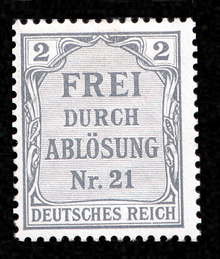Badge
Officials (individually also briefly brand ) are stamps that only by authorities , agencies or offices are used for franking mail service mail. They are therefore not sold at the post office counter and are not approved for private or business mail. A theft and abuse therefore of officials is practically non-existent.
history
The first official stamps were to be issued in Great Britain at the same time as the One Penny Black in 1840 , but never got into circulation. The brand was the same as One Penny Black with one difference, it had the letters V and R (for Victoria Regina ) in the upper corners. Of the 3,323 sheets printed, all but 21 were burned in January 1843.
The first official stamps actually used were issued in Spain in July 1854. These were stamps with a black national coat of arms, printed on colored paper. At the lower edge of the picture they had weight information on the maximum letter weight permitted for carriage.
In the 19th and early 20th centuries, badges were used almost worldwide. Often, service stamps were made from postage stamps by printing. Typical imprints are OFFICIAL , OHMS ( On Her / His Majesty's Service ), OFFENTLIK SAK (Norway) or TJENESTE (Denmark).
In Germany, the first general official stamps were issued in 1920. However, they were abolished again after the Second World War (see also: Official stamps (German Empire) ). Independent official stamps existed in Bavaria (1908 to 1920), Württemberg (1875 to 1920), the North German Confederation (1870 to 1871) and in the Free City of Danzig (1921 to 1927).
In the Federal Republic there were no more official stamps. In the GDR , items from state organs, administrations and companies had to be franked with official stamps from August 15, 1954 .
In Austria, official stamps are only found at the time of the Anschluss between 1938 and 1945.
Switzerland also issued its own official stamps from 1910 to 1962; these were valid until September 30, 1969. In Liechtenstein, official stamps were issued between 1921 and 1989; these were valid until December 31, 1994.
From August 23, 1945, there were also official stamps in Czechoslovakia, but they were only used in Slovakia until June 30, 1948.
In Hungary there were official stamps from June 23, 1921, the validity expired on January 31, 1925 at the latest.
Other types of badges
Special forms of official stamps are official counter stamps which were issued for 12 months in the state of Prussia from January 1, 1903 . The states of the German Empire had signed so-called replacement agreements with the Reichspost , which provided for an annual down payment for the official mail carried without postage. Both the Reichspost and the federal states were dissatisfied with the procedure at the beginning of the 20th century, as the Reichpost lost revenue and the federal states assumed a lower volume of mail than estimated by the Reichspost. To determine the actual volume of mail, from January 1, 1903, all official mail in Prussia was marked with special official stamps in the Germania frame, with the inscription FREI DURCH ABLÖSUNG No. 21 . The procedure was repeated in 1905 for the state of Baden . The result of the census showed a much lower volume of service mail than assumed by the Reichspost and a corresponding reduction in the advance payments.
In 1963 a similar procedure with special service counters was also carried out in Thailand .
Service parcel stamps were in use in the UK from 1882 to 1902. To this end, 17 postal stamps of the then current series with a two-line labeling were GOV T . PARCELS provided.
The brands of the Central Courier Service , which was active in the GDR from 1956 to 1965, are called courier service brands .
literature
- Michael Burzan: Official stamps in Bavaria since 1908. In: Deutsche Briefmarken-Zeitung Edition 2/2008, p. 90 f
- Ullrich Häger: Large encyclopedia of philately . Bertelsmann, Gütersloh 1973. ISBN 3-570-03229-9 . Pp. 108-109
- James Mackay: Guinness Book of Postage Stamps . 2nd edition, Ullstein, Frankfurt / M., Berlin, Vienna 1986. ISBN 3-550-07695-9 . Pp. 88-89



